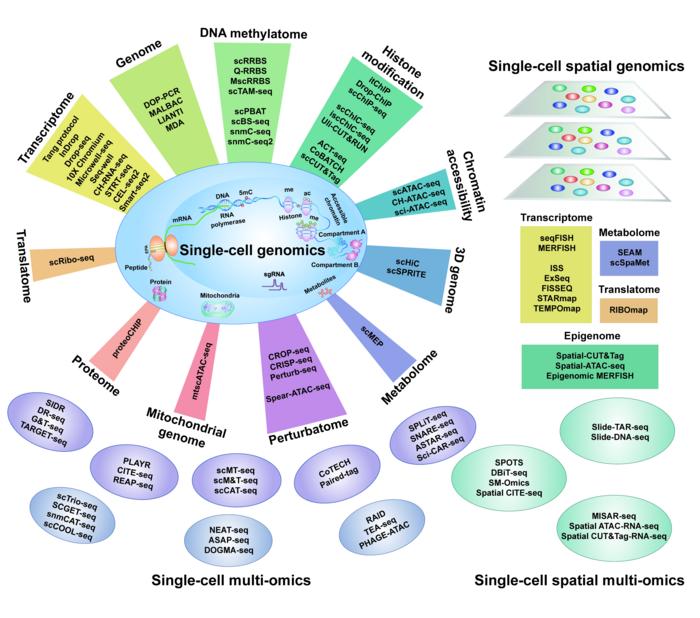
The landscape of biology is undergoing a radical transformation, driven by advances in single-cell and spatial genomics. This cutting-edge research area focuses on analyzing not just the collective behavior of groups of cells, but the intricate details of individual cells and their contextual environments within tissues. The recent scholarly review from a collaborative team of distinguished researchers at Zhejiang University, Peking University, and BGI Research highlights how these emerging technologies are reshaping our understanding of cellular dynamics, disease mechanisms, and therapeutic interventions.
Central to this evolving narrative is the development of single-cell sequencing technologies. The journey began with fundamental RNA sequencing, which allowed for the capture of gene expression at an individual cell level. The evolution from these rudimentary methods to comprehensive genomic, epigenomic, and proteomic sequencing marks a significant milestone in genomic analysis. The transition from single-omics to multi-omics is noteworthy, as it permits a holistic examination of a cell’s multifaceted biological profiles, enabling scientists to dissect complex cellular behaviors in unprecedented detail.
Moreover, the remarkable increase in sequencing capacity has opened doors to new possibilities. The review details how modern sequencing technologies are able to process thousands of individual cells simultaneously, generating vast datasets that hold the key to deciphering the complexities of cellular life. By transitioning from studying whole cells to probing deep into subcellular compartments, researchers are now able to uncover layers of biological information previously obscured by the averaging effects of bulk analyses.
Additionally, single-cell multi-omics technologies have emerged as a pivotal area of research, catalyzing breakthroughs in our understanding of cellular diversity and function. By integrating innovative techniques such as microfluidics, pipetting, and flow cytometry, researchers are now able to separate individual cells while minimizing data loss and maximizing the integrity of the resultant omics data. This high-resolution approach is transforming the ways we investigate cell performance and interaction, especially in heterogeneous tissues such as tumors or developing embryos.
The historical trajectory of spatial transcriptomics and multi-omics is also a focal point of the review, showcasing the significant advancements made over the past two and a half decades. Four key technologies have been identified as milestones in this journey, each playing a crucial role in fields such as developmental biology, neuroscience, and pathology. These innovations underline the importance of spatial context in understanding the functional dynamics of cells, shining a light on how the organization and location of cells within tissues can influence their behavior and role in health and disease.
In the realm of computational analysis, the complexities inherent in single-cell genomic data demand sophisticated modeling approaches. The review outlines cutting-edge strategies that leverage deep learning techniques to construct detailed models of cell atlases, enabling researchers to visualize and interpret multi-layered data with greater clarity. However, the review also addresses the computational challenges that arise when attempting to analyze vast datasets from different platforms and species, emphasizing the need for standardized methodologies to advance comparative genomics.
The exploration of cross-species and cross-tissue cellular atlases emerges as an integral part of this discourse. Since the inception of the Human Cell Atlas initiative in 2016, there has been a concerted effort to compile cellular atlases that not only serve as invaluable references for human biology but also allow for comparative studies across different model organisms. The implications of such research are profound, providing foundational insights that can enhance our understanding of human health and disease from a broader biological perspective.
Particularly exciting are the clinical applications of single-cell genomics as outlined in the review. The ability to dissect cellular heterogeneity within tumors has significant ramifications for precision medicine, allowing for more targeted and effective cancer therapies. Beyond oncology, insights from single-cell analyses are proving pivotal in the treatment of non-cancer diseases and the identification of novel drug targets. The potential for translating these groundbreaking discoveries into clinical practices represents a monumental step forward in personalized medicine.
As the review looks towards the horizon, it illuminates the myriad challenges and opportunities presented by the future of single-cell and spatial genomics. The enhanced throughput, sensitivity, and modalities offered by these technologies offer unprecedented chances to propel biomedical research into a new era. Emphasizing the transformative potential of artificial intelligence in this domain, the review conveys a vision where machine learning algorithms could significantly expedite disease target discovery and streamline drug development processes.
In essence, the advancements and applications of single-cell and spatial genomics are not merely incremental. They signify a paradigm shift—ushering in an era where in-depth cellular insights are translated into concrete clinical interventions. This consolidation of fundamental research and clinical applications is not only poised to enhance our understanding of complex biological systems but also catalyze the development of innovative therapies aimed at combating diseases and promoting human health. As the scientific community continues to explore these revolutionary technologies, the future looks promising, offering immense potential to reshape our approaches to diagnostics and therapeutics in the coming years.
Subject of Research: Advances in single-cell and spatial genomics
Article Title: Advances and applications in single-cell and spatial genomics
News Publication Date: [Not provided]
Web References: [Not available]
References: [Not available]
Image Credits: ©Science China Press
Keywords: Single-cell genomics, spatial genomics, multi-omics, sequencing technologies, computational analysis, precision medicine, cellular atlas, artificial intelligence, drug development.





